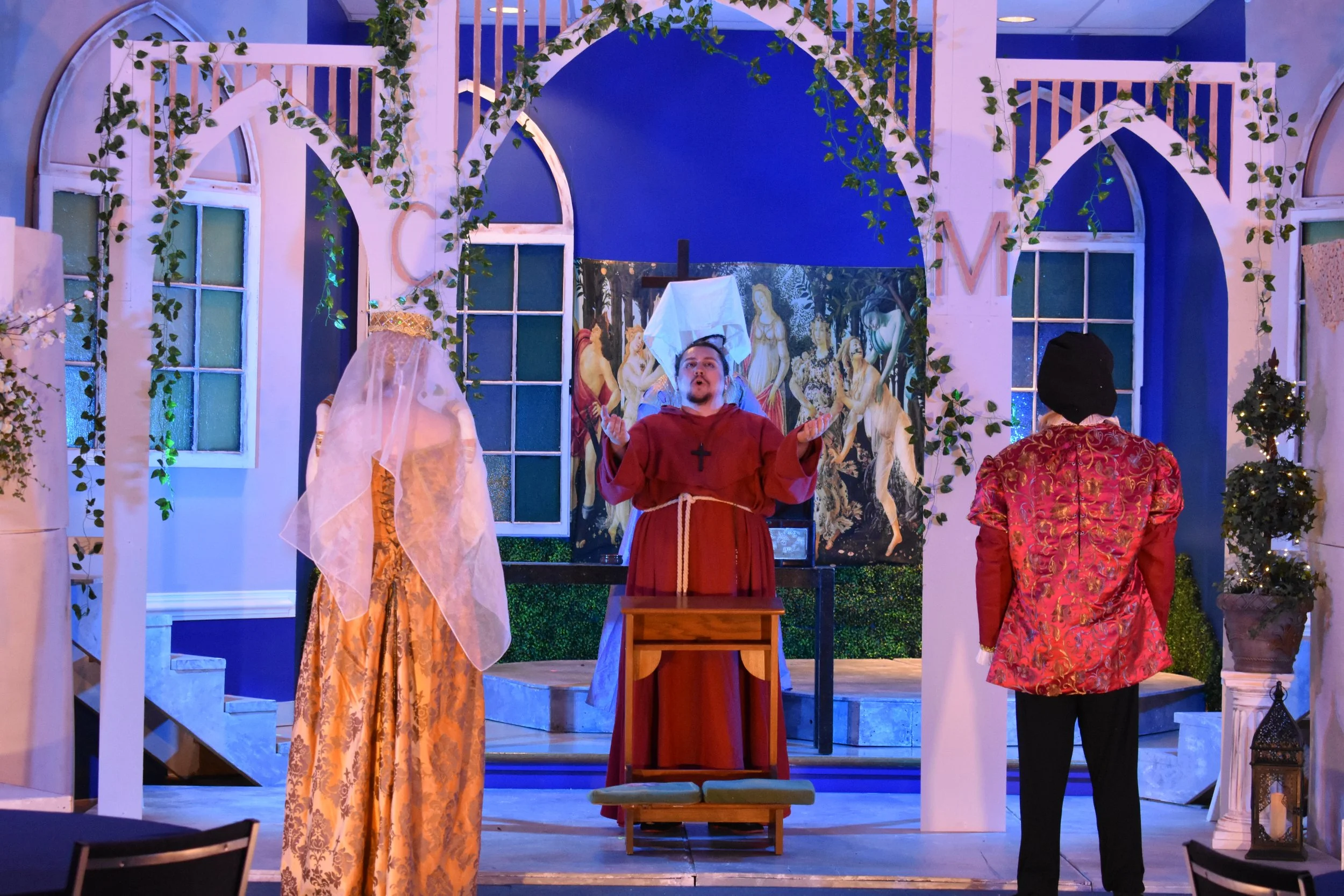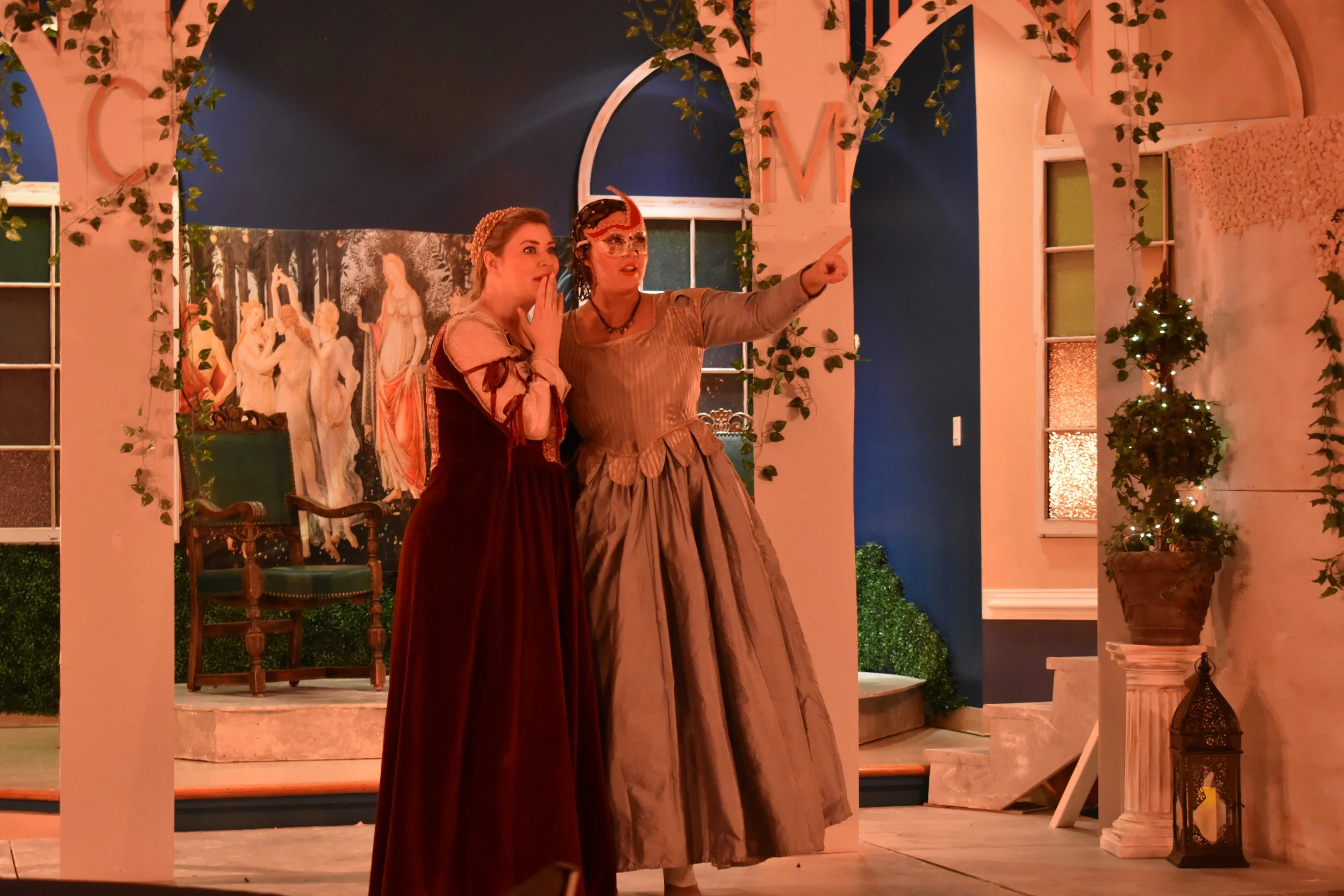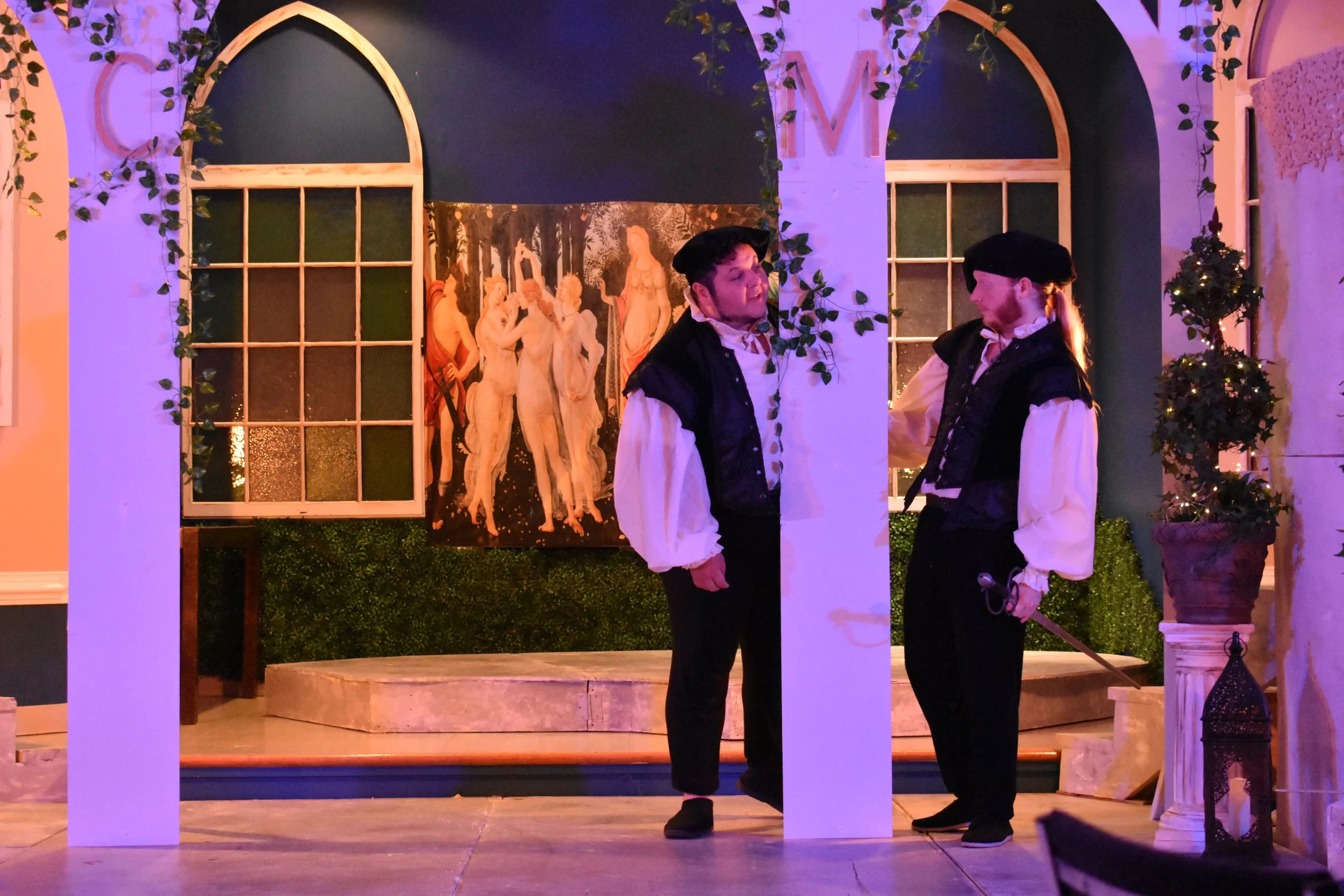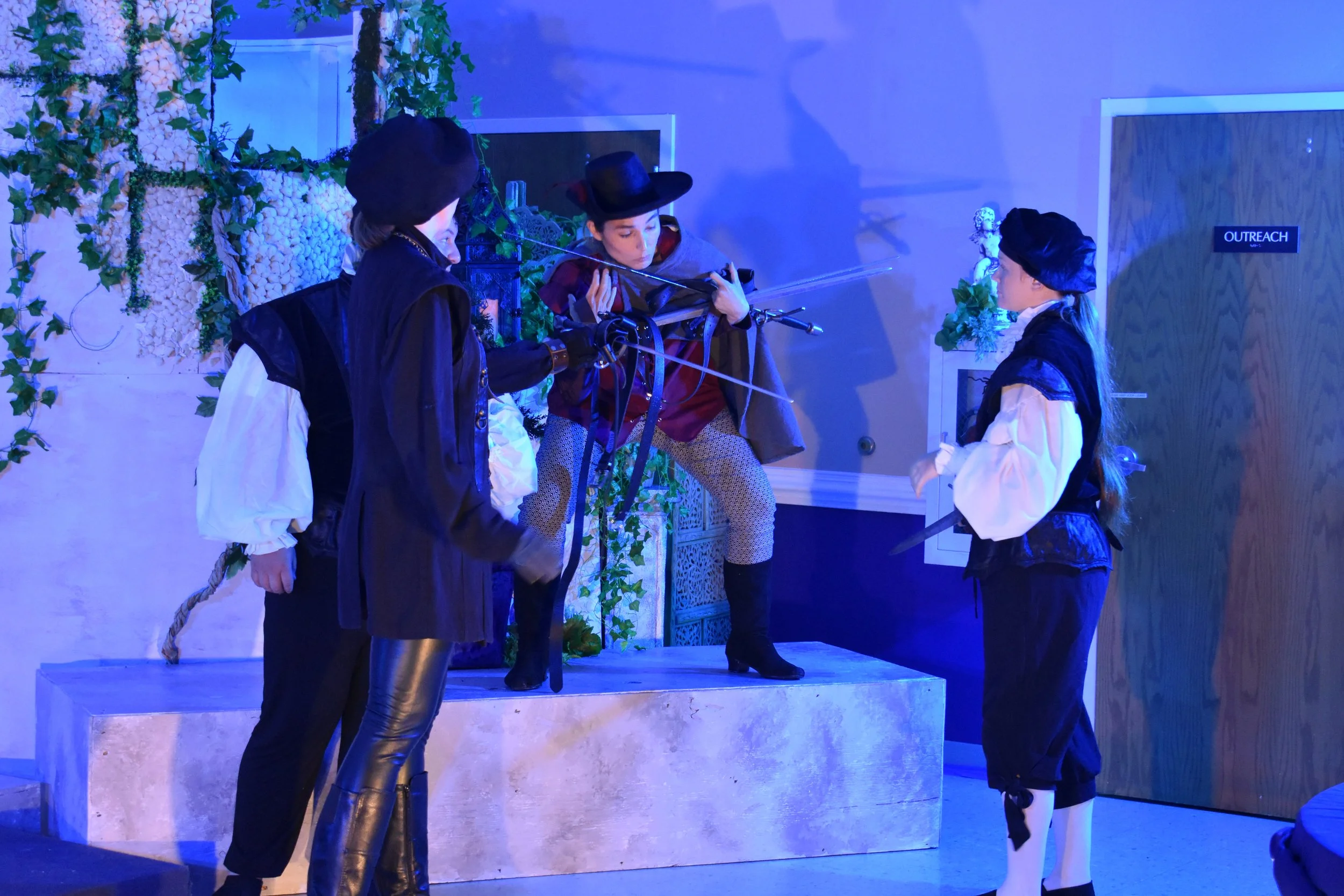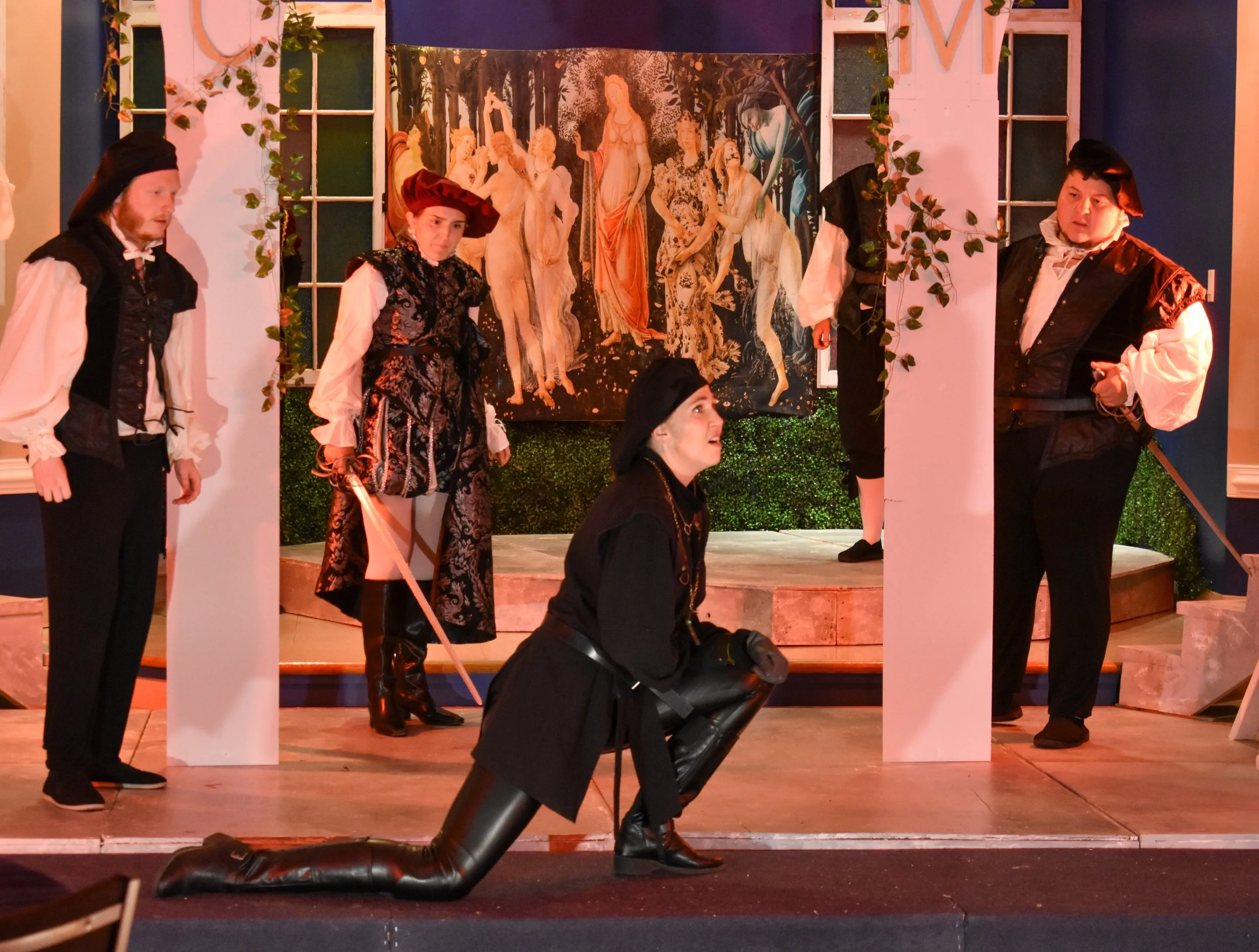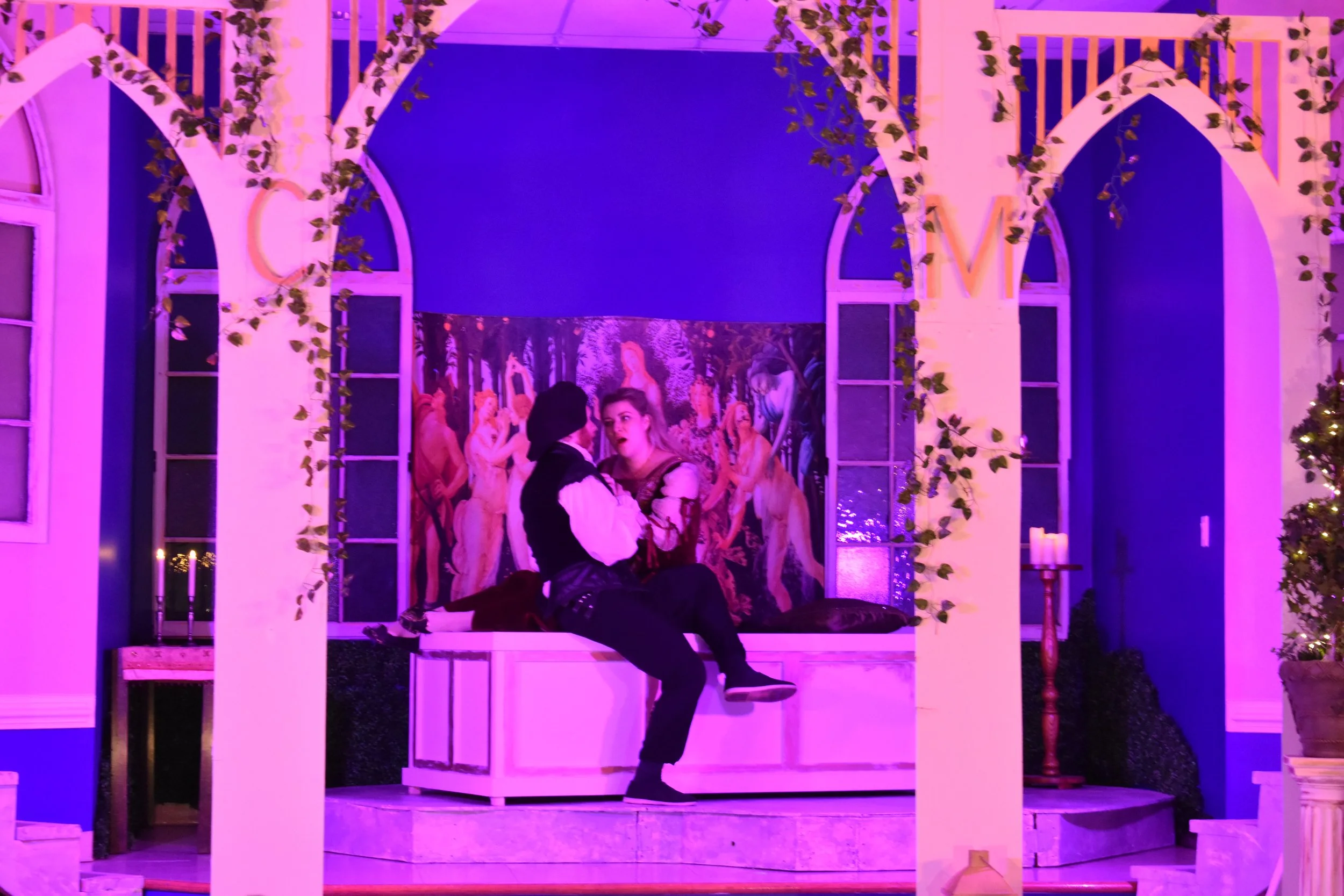Oh, those Montagues and Capulets were at it again, this time viewed from two perspectives, that directly from Shakespeare himself, a composer of words, and that in a musical fashion by Charles Gounod, a composer of music, including an opera based on Shakespeare’s play. There were several highlights of this production that I will mention, but the star of the show was Dr. Lori Lind’s exceptional knowledge, resourcefulness, and creativity in bringing to life this highly entertaining synthesis of Shakespeare’s play and Gounod’s opera, taking passages directly from both. Dr. Lind, Founder, and Artistic & Managing Director, of Shakespeare Opera Theatre, closed the company’s tenth anniversary season with this production, for which she served as stage director, production designer, production manager, and set designer, not to mention chief synthesizer, greeter, spokesperson, and fundraiser. She has also assembled a highly dedicated and resourceful team needed to generate and sustain such quality. In almost every way, Shakespeare Opera Theatre exceeds expectations one might have of a local opera theatre company, all done for love of the art forms and not for profit. Attendance, spotty in the early days, is now robust; all but one of seven of SOT’s performances of Romeo & Juliet were sold out.
A happy moment as Juliet and Romeo are married in secret by Friar Lawrence (Justin Ramm-Damron). All photos by Lauren Sanfiel Armstrong at the dress rehearsal; courtesy of Shakespeare Opera Theatre.
My favorite aspects of Sunday’s matinee performance included: an original production; a talented, engaging set of young professionals; exciting action including swordplay; standout performances by the SOT’s Romeo and Juliet; beautiful music, an impressive staging making optimal use of limited quarters; and the transcendent experience of hearing an exceptional chorus while seated in the middle of the ensemble. Unfortunately, personal circumstances only made it possible for me to catch the last performance in its run; so, I can only tell you what you missed and not recommend that you go. My comments, though, might spur you to attend performances during next year’s season.
Juliet (Chelsea Alexandra) confering with her nurse Gertrude (Olivia Currier). Photo by Lauren Sanfiel Armstrong; courtesy of Shakespeare Opera Theatre.
Romeo and Juliet are the star-crossed young lovers who wind up dying for each other as a result of their feuding families, who keep them apart, and as a result of an ill-fated plan to allow them to escape together. Shakespeare’s Romeo and Juliet, composed in English, includes more social context for the tragic love story, while Charles Gounod’s Roméo et Juliette focuses on the love story, with a substantially modified ending. Dr. Lind’s goal in these combos is “to showcase the best of both worlds” and allow fans of one genre a chance to experience the other. SOT’s mashup provides some of the comedy in the play, though, SOT leans more towards the opera in the ending, as a self-poisoned Romeo does not expire before Juliette awakens from her death-like slumber, a ploy which allows the lover’s one more beautiful duet. I can’t resist adding that the mashup doesn’t deal with the fact that Juliet was not yet 14 and Romeo only a couple of years older; had the families just insisted that they date for a while before marrying, these impetuous youths might have moved on. Also, given our divisive times, I found myself focusing more on the families’ senseless feuding causing the deaths than I have in the past. SOT’s amalgamation addresses that but like the opera omits the final scene showing the grieving families who then dispatch with their enmity because of their losses. Nonetheless, we all love a good love story, and I enjoyed the beautiful, lively telling of this one.
Romeo (Joseph McBrayer) confides in his friend, Abraham (Nicholas James). Photo by Lauren Sanfiel Armstrong; courtesy of Shakespeare Opera Theatre.
The performance began with Stephano, a Montague servant, played by mezzo-soprano Julie Silva in a pants role. making a rude gesture to Sampson, a Capulet servant played by actor Sommer Schaap, which caused Gregorio, a Capulet played by SOT veteran baritone JP Gorski to think it was directed at him, The confrontation quickly led to a well-executed sword fight among youths from the two families, an action-packed beginning; several such fights were in the performance, impressively executed in such tight quarters. Kudos to Fight Choreographer Casey Caleba and Fight Director Nickolas James. Ms. Silva later displayed impressive singing skills performing Stephano’s highlight aria, "Que fais-tu, blanche tourterelle", taunting the Capulets. The opening battlers were authoritatively called to task by the Prince of Verona from the back of the room, sung by bass-baritone Justin Ramm-Damron who also played the role of Friar Lawrence; as Prince, he declared that further unruliness would have the serious consequence of banishmen. He was quite enjoyable as the Friar and possessed one of the highest quality voices in the performance. Overall, I counted seventeen players in this production moving deftly about a small stage, many with singing roles, some with more than one role, some moving props about, adding energy and their talents to the production. Kudos to Stage Director Lind for keeping the action tight.
Soprano Chelsea Alexandra and tenor Joseph McBrayer played the roles of Juliet and Romeo with great appeal, making their love story engaging. Ms. Alexandra has a soprano voice that is a pleasure to hear; she was a bit reserved in her singing of Juliet’s famous aria, “Je veux vivre”, but it was quite enjoyable. One would certainly like to hear more from her. The duets between this Juliet and this Romeo were a highlight of the opera; their trips to the crypt were especially compelling. Mr. McBrayer had me at his first aria, a lovely voice singing beautifully, a good complement for Juliet. His acting needed sharpening but he and Ms. Alexandra made an excellent pairing. Mezzo-soprano Olivia Currier who plays Juliet’s nurse Gertrude was a hoot, singing well and being the comical center of the production.
Stephano (Julie Silva) comically fumbles a group of swords. Photo by Lauren Sanfiel Armstrong; courtesy of Shakespeare Opera Theatre.
A surprise in the production was having the hotheads, Capulet Tybalt and Montague Mercucio, performed as pants roles. Tybalt was sung by vocalist Catie Brooks and Mercutio was sung by mezzo-soprano Louise Andersen. The choices were made by Director Lind after all performers had interviewed for slots in the opera. In fact, both were delights as performers in their roles, but though Ms. Andersen managed a sinister aura and Ms. Brooks was impulsive, for me neither projected the violently menacing quality I have become accustomed to in these characters who will lose their lives in sword fights as a result. Benvolio, the peace maker was played by tenor Jason Guerrero, and Paris, the Capulet choice for Juliet, was played by baritone Vincent Fung; both played their characters well.
Mercutio (Louise Andersen) has been fatally wounded by Tybalt (Catie Brooks) standing in the back, as Romeo (Joseph McBrayer) on right and Abraham (Nicholas James) on left look on. Photo by Lauren Sanfiel Armstrong; courtesy of Shakespeare Opera Theatre.
The attractive and impressively functional set was designed by Dr. Lind, featuring a middle section with an arch that could be refashioned as a ballroom, meeting room, courtyard, bedroom, or tomb as needed, flanked by a court with a balcony for Capulets and on the other side a tower for the Montagues with a bench against its wall. Given that the seating was not tiered, I would have preferred if the bed for Romeo and Juliet’s bedroom scene had been raised for a better view for those in the back. Another issue for some attendees was difficulty seeing the supertitles screen; Dr. Lind, ever committed to making attendance of SOT performances memorable as a good experience, offered them free tickets to a future production.
The costumes were a pleasure to see, fitting for Verona in the fourteenth century; kudos to Susan Gardiner for costume design and fabrication. The dialog was in English, and the vocals were in both Italian and English depending on content. Dr. Lind explained that where comedy and context was important the vocals were presented in English while for the lyrical, beautiful arias, French was used.
Gounod’s beautiful lyrical music for the performance was handled by Andrew Kraus as music director, vocal coach, and conductor for this production. He also played the piano providing music for the production. He not only provided music for the arias, recitatives, and choral singing, he also played lovely background music during some of the scenes with action and dialog only, which worked to enhance the scenes, though at one point I noticed the music was making hearing the dialog more difficult. An unexpected highlight of the performance was two ensemble numbers performed surrounding the audience. Dr. Lind related that “the first that ended the first half of the program in Act III was O Day of Woe! and the one in Act IV was the rarely performed Epithalamium”. The immersive sound from voices of this quality in this venue was transcendent, an experience I will long remember. The music side was well done overall, and many kudos to her and Mr. Kraus.
Romeo (Josepah McBrayer) and Juliet (Chelsea Alexandra) share their last duet before their deaths. Photo by Lauren Sanfiel Armstrong; courtesy of Shakespeare Opera Theatre.
Finally, I love Shakespeare’s play, and I like Gounod’s opera; I typically find that the Bard’s iambic pentameter creates its own music. Shakespeare Opera Theatre’s combination of scenes from both the play and opera worked well in telling the lover’s tragic story and providing moments from both to enjoy; it was charming, fun, and highly entertaining. But as a grandfather speaking, since the Prince of Verona is unavailable, let’s not allow the artistic beauty of a tragic love story cause us to overlook, in the end, that this is a tale of woe and that the cause of the untimely deaths of a cherished daughter and a cherished son, two innocents, was enmity and feuding.
The Fan Experience: Performances of Romeo & Juliet were scheduled by Shakespeare Opera Theatre in St. Thomas Episcopal Church in Mclean for July 11, 12, 13, and 14, and in Grace Episcopal Church in The Plains on July 18, 19, and 20. The performance with one intermission lasted about 2 hours and 45 minutes. Some roles featured different singers in different venues.
Shakespeare Opera Theatre’s 2025-2026 season has been announced, though dates for the opera performances are yet to be firmly set. In addition to the opera/theater productions of Hansel & Gretel (December), Tartuffe (June), and Susannah (July, an American opera performed to honor the U.S.’s 250th birthday), two concerts will be offered (“Oktoberfest” on October 12, 2025 and “Viva Las Vegas” on February 14 (Valentines Day), 2026.
The was my first visit to The Plains to attend an SOT performance. The Plains venue is similar in size though not the same as the Mclean venue. It has a beautifully shaped wooden ceiling. I thought that the dialog from the stage did not carry quite as far for this venue, but that said, the ensemble choral performances were likely given more texture by the walls and ceiling there. The Grace Episcopal Church is a beautiful structure which has historical stained-glass windows that can be viewed as opportunity allows; one of the windows includes George Washington.
The Plains venue had the same party atmosphere one finds in the Mclean location. I have found little pretense with SOT; they readily own their limitations and still manage to engage us fully. Dress is “as you like it” and seating is at tables. Snacks and drinks are offered for sale which can be consumed before, during, or after performances. Attendance by children is welcomed. Performers and staff are typically available for questions, picture taking, and mingling after performances.
This report, as is usual, has benefited immensely from my wife Debra serving as copy editor. My wife writes a travel blog called fiammatravels.com for which I serve as the copy editor.

